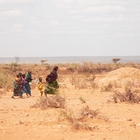study
Somalie
Dollow Settlements for Internally Displaced Population
2021
© Fardosa Hussein for Action Against Hunger
Mother and baby at stabilisation center
Mother and baby at stabilisation center
Link NCA Dollow Final Report
Analystes

Lenka Blanárová

Mohamed Muhumed Yussuf
Managing organization
UNICEF
UNICEF
funder
UNICEF
UNICEF
This Link NCA study consisted of primary qualitative data collection and secondary quantitative data analyses using datasets provided by Food Security and Nutrition Analysis Unit (FSNAU) covering Gu and Deyr seasons between 2014 and 2020.
Out of 17 risk factors believed to have an impact on the incidence of undernutrition in the study zone, 4 risk factors were identified as having a major impact, namely non-optimal breastfeeding practices, non-optimal complementary feeding practices, low access to income sources and low coping capacities.
Based on available data provided by FSNAU, common risk factors for wasting on the basis of at least one index (weight for height z-score (WHZ), MUAC or WHZ and/or MUAC), stunting and underweight include a male child, the occurrence of morbidities, including diarrhoea and pneumonia, and the household’s dependence on gifts/zakaat as their primary source of income. On the other hand, children were less likely to be wasted, stunted or underweight if they received Vitamin A supplementation, consumed cereals or any meat, their household owned land or declared petty trade as their primary source of income.
Out of 17 risk factors believed to have an impact on the incidence of undernutrition in the study zone, 4 risk factors were identified as having a major impact, namely non-optimal breastfeeding practices, non-optimal complementary feeding practices, low access to income sources and low coping capacities.
Based on available data provided by FSNAU, common risk factors for wasting on the basis of at least one index (weight for height z-score (WHZ), MUAC or WHZ and/or MUAC), stunting and underweight include a male child, the occurrence of morbidities, including diarrhoea and pneumonia, and the household’s dependence on gifts/zakaat as their primary source of income. On the other hand, children were less likely to be wasted, stunted or underweight if they received Vitamin A supplementation, consumed cereals or any meat, their household owned land or declared petty trade as their primary source of income.





